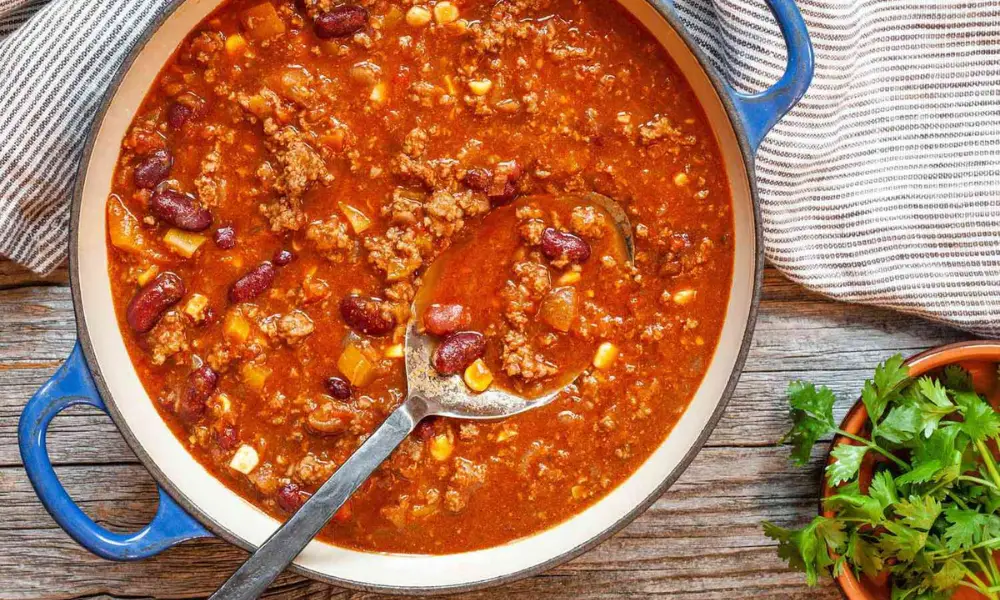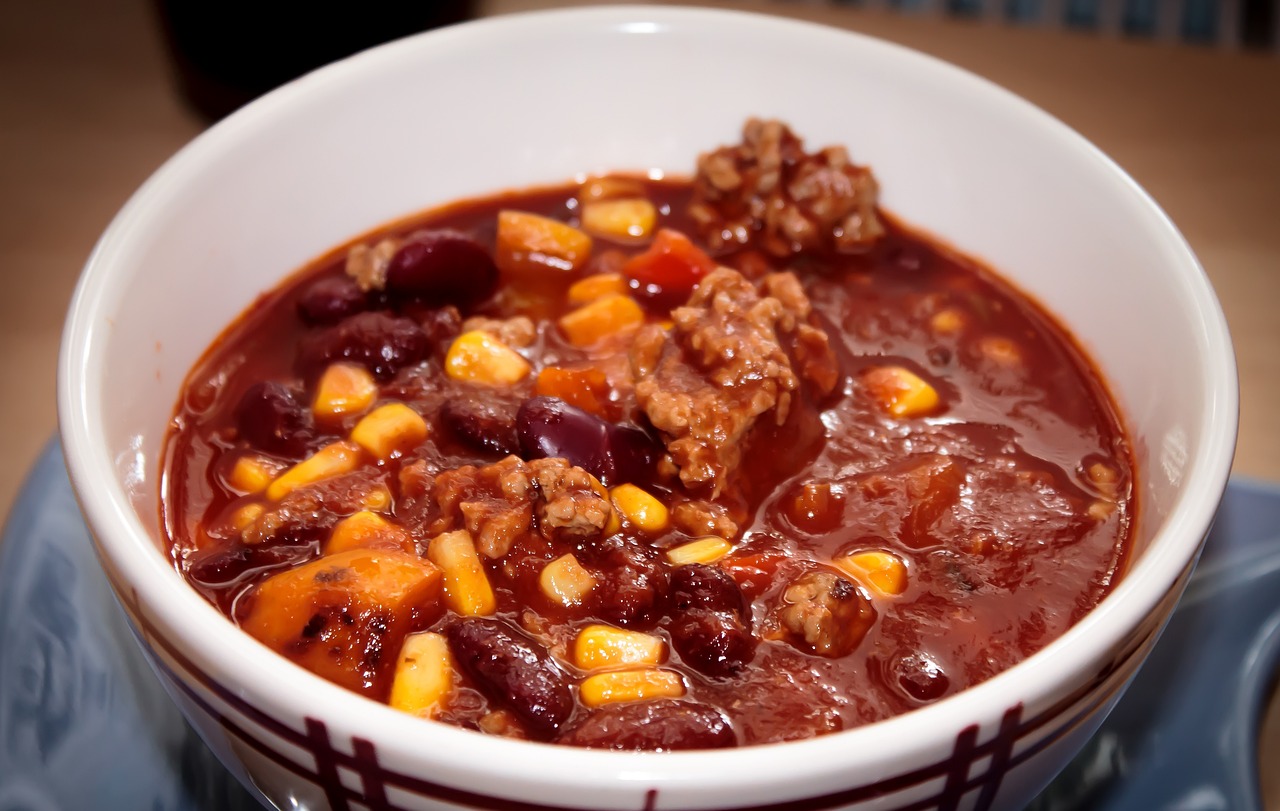Reheating chili in the microwave is a quick and convenient option for a quick lunch or dinner. However, it’s important to properly reheat your chili to ensure it is safe to eat and retains its delicious flavor.
When making chili for a meal, it can be hard to know how long you can reheat it in your microwave. If you plan on serving your family chili, the chili must maintain a warm temperature for everyone to enjoy.
Fortunately, you can take a few simple steps to reheat your chili without wasting time or heating up your house. This article will give step-by-step instructions on how long to reheat chili in the microwave and some tips to ensure your chili comes out perfectly every time.

How Long to Reheat Chili in Microwave?
Generally, reheating leftover chili in the microwave is a quick and simple meal method. If reheated properly, chili can stay cooked, dry, and even contaminated with harmful bacteria. To reheat chili in the microwave, start by transferring the chili to a microwave-safe container.
If the chili is stored in a plastic container, ensure it is microwave-safe before proceeding. If the chili is stored in a metal container, transfer it to a microwave-safe dish before reheating. Next, cover the chili with a microwave-safe lid or plastic wrap, leaving a small opening to vent steam. This helps to keep the chili moist and prevents it from drying out while it is being reheated.
Now it’s time to reheat the chili. Place the covered container in the microwave and set the power level to 50% or medium. This helps to prevent the chili from overheating and ensures that it is heated evenly. The time it takes to reheat chili in the microwave will depend on the quantity of chili you are reheating and the wattage of your microwave.
Generally, it will take about 2-4 minutes to reheat a single serving of chili and about 5-7 minutes to reheat a larger portion. Check the chili every minute to ensure it is heated to your desired temperature. Once the chili is heated to your desired temperature, please take it out of the microwave and give it a moment or two to sit before serving.
This will allow the heat to distribute throughout the chili and help to prevent burns evenly. As an added tip, you can add broth or water to the chili before reheating it to help keep it moist and prevent it from drying. You can also sprinkle a little cheese on top of the chili before reheating to give it a creamy, cheesy texture. Following these simple steps, you can easily and safely reheat chili in the microwave, ensuring a delicious and satisfying meal every time.
Additional Tips for Reheating Chili Perfectly in the Microwave
- Use a microwave-safe container that allows steam to escape to prevent soggy chili.
- Stir the chili well during the reheating process to ensure even heating.
- Properly store leftover chili in the refrigerator to prevent bacterial growth.
- Check the chili’s internal temperature with a food thermometer to ensure it has reached a minimum of 165°F before consuming it.
- If the chili seems too thick or dry after reheating, add a splash of broth or water to moisten it.
- It’s crucial to add moisture to chili. By doing this, the chili will avoid drying out, which might result in food illness.
- If you’re reheating chili that has been kept in the refrigerator, make sure you microwave it for a full two minutes to eliminate any dangerous bacteria.
Why does Reheated Chili Taste Better?
Generally, there are a few reasons why reheated chili may taste better than when it was first prepared. It’s a matter of personal preference, but many people find that the flavors of the ingredients have had time to meld and intensify and that the texture of the chili has changed, making it more enjoyable to eat.
- Time to develop flavors: Chili tastes better the longer it cooks, as the flavors have time to meld and develop. When the chili is reheated, the flavors have more time to deepen and intensify, making it taste better.
- The Maillard reaction: When proteins and sugars are heated together, a chemical event known as the Maillard reaction takes place, leading to the creation of new taste molecules. When reheated, chili can undergo this process, enhancing the flavor.
- Evaporation: When the chili is reheated, some liquid in the dish may evaporate, concentrating the flavors and making them more intense.
- Refrigeration: Chili that has been refrigerated and then reheated may taste better due to the cooling process. When the chili is chilled, the flavors have a chance to settle and intensify, which can make it taste better when it is reheated.
How Many Times can you Reheat Homemade Chili?
To reheat chili, place it in a pot on the stove over medium heat and occasionally stir until it is heated. It is generally safe to reheat chili several times as long as it is handled properly. However, the quality of the chili may decline with each subsequent reheating.
To help protect against the spread of foodborne illness, reheat the chili to at least 165°F (74°C). Alternatively, you can microwave the chili in a microwave-safe container, stirring every minute to ensure that it heats evenly. It is also a good idea to discard any leftover chili that has been sitting in the refrigerator for more than 3-4 days, as it may have lost few of its freshness and flavor.
How can you Make Chili More Tastier?
There are many ways to make chili more flavorful. Here are a few ideas:
- Add more spices: Chili is a great opportunity to experiment with different spices and seasoning blends. Some options include cumin, chili powder, paprika, oregano, and garlic powder.
- Use fresh herbs: Chopped herbs, such as cilantro, parsley, and basil, can add a bright and fresh flavor to the chili.
- Add some sweetness: A little bit of sweetness can help balance out the heat and richness of chili. Add a small amount of brown sugar, honey, or maple syrup.
- Use a variety of beans: Mixing up the types of beans you use in your chili can add intensity and complexity to the flavor.
- Add some acidity: A splash of vinegar or a squeeze of lime juice can help brighten up the flavors in chili.
- Experiment with different types of meat: Ground beef is the most common meat used in chili, but you can also try using ground pork, lamb, or turkey. Add diced pieces of beef, pork, or chicken to your chili.
- Add some heat: If you like spicy food, try adding some extra chili peppers or hot sauce to your chili. You can also add diced jalapeno peppers or a pinch of cayenne pepper to increase the heat.
- Add some dairy: A dollop of sour cream or a sprinkle of shredded cheese can add a rich and creamy flavor to the chili.
- Use good-quality ingredients: Using high-quality ingredients can make a big difference in the flavor of your chili. Choose ripe, fresh vegetables and flavorful cuts of meat, and use good-quality canned tomatoes and beans.
How Long does Chili Last?
Chili can remain fresh for several days in the freezer or refrigerator. Here are some recommendations for preserving chili: it’s important to note that these are just general guidelines, and the actual shelf life of chili may vary depending on several factors, such as the quality of the ingredients and how the chili was prepared.
- In the Refrigerator: Chili should be kept in the refrigerator in an airtight container where it will keep its freshness for 3–4 days. The chili can be frozen in an airtight bag or container for up to 3–4 months if you wish to keep it longer.
- In the Freezer: Chili can last in the freezer for 2-3 months when stored in an airtight container. Leave enough headspace in the container when putting chili in the freezer to allow for expansion as the chili freezes.
- At Room Temperature: Chili should be left for at most 2 hours. Food that has bacteria growing on its surface is dangerous to consume.
How can you Tell Chili has Gone Bad?
It’s always a good idea to use your senses (sight, smell, taste) to determine if chili has gone bad. If the chili has an off smell, visible mold, or has changed in color, texture, or taste, it’s best to discard it to avoid the risk of food poisoning. If you need clarification on whether your leftover chili is still safe to eat, it’s always wise to err on caution. Here are some signs listed below:
- Mold: If mold grows on the chili’s surface, it should be discarded immediately. Mold can be toxic and can cause serious illness if ingested.
- Off smell: Fresh chili should have a pleasant, savory aroma. If the chili has an unpleasant or sour smell, it may be spoiled and should be discarded.
- Change in texture: If the chili has a slimy or congealed texture, this is a sign that it has gone bad and should not be consumed.
- Color change: Fresh chili should have a rich red color. If the color has changed to a brown or grey hue, this may be a sign that the chili has gone bad and should not be consumed.
What Happens if you Consume Bad Chilies?
Chili can go bad in several ways, including being kept at room temperature for too long. Consuming bad chilies can cause food poisoning, leading to various symptoms, including stomach pain, nausea, vomiting, and diarrhea. In serious cases, food poisoning can lead to more serious health complications, such as kidney failure or even death.
When the chili is kept in a very hot place or not properly sealed or stored, when the chili is left out at room temperature, bacteria can grow on the surface of the food, making it unsafe to eat. Similarly, storing chili in a warm environment can allow bacteria to grow and multiply, increasing the risk of food poisoning.
It’s important to pay attention to the expiration date of chili and other perishable foods and to store them properly in the refrigerator or freezer. It’s also important to cook chili thoroughly to kill any bacteria that may be present. If you suspect you have consumed bad chili, monitoring your symptoms and seeking medical attention if necessary is important.
To reduce the possibility of food poisoning, handle and store chili and other perishable foods properly and cook them thoroughly before consuming them. It’s also a good idea to pay attention to these foods‘ expiration dates and discard any that have gone bad. In some cases, food poisoning can be treated with over-the-counter medications, but hospitalization may be required in severe cases.
Conclusion
In conclusion, the best way to reheat chili in the microwave is to use short, 30-second intervals and stir the chili well between intervals. This will assist in dispersing the heat evenly and stop the chili from drying out or overcooking. To assist in keeping moisture and stopping splatters, it’s also a great idea to shield the chili with a damp paper towel or microwave-safe lid.
Hopefully, this article helps you reheat and enjoy chili every time. Overall, it’s important to take care when reheating chili in the microwave to ensure that it is heated thoroughly and safely. To ensure that the chili is heated to a safe temperature, use a food thermometer to check that it has reached an internal temperature of at least 165°F.
